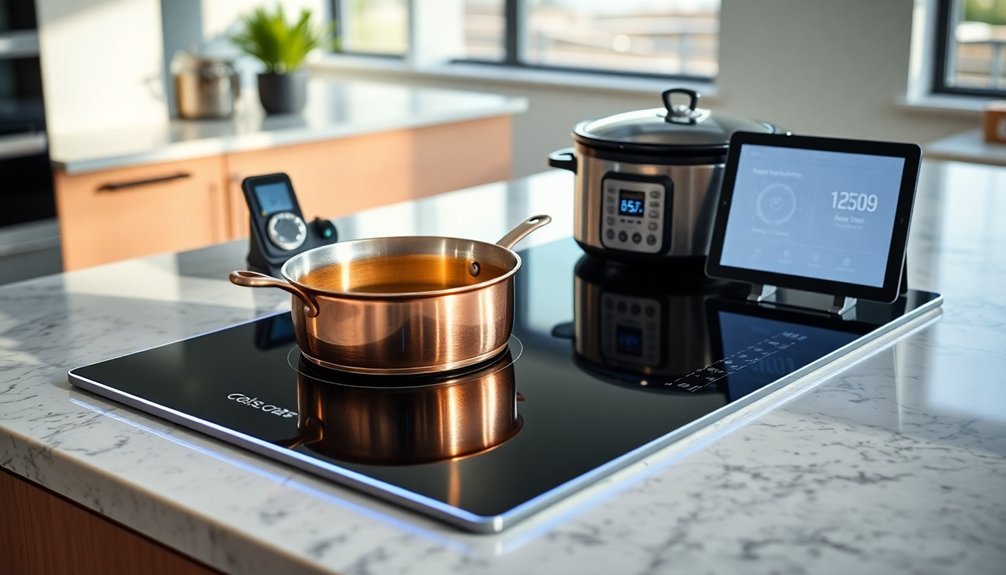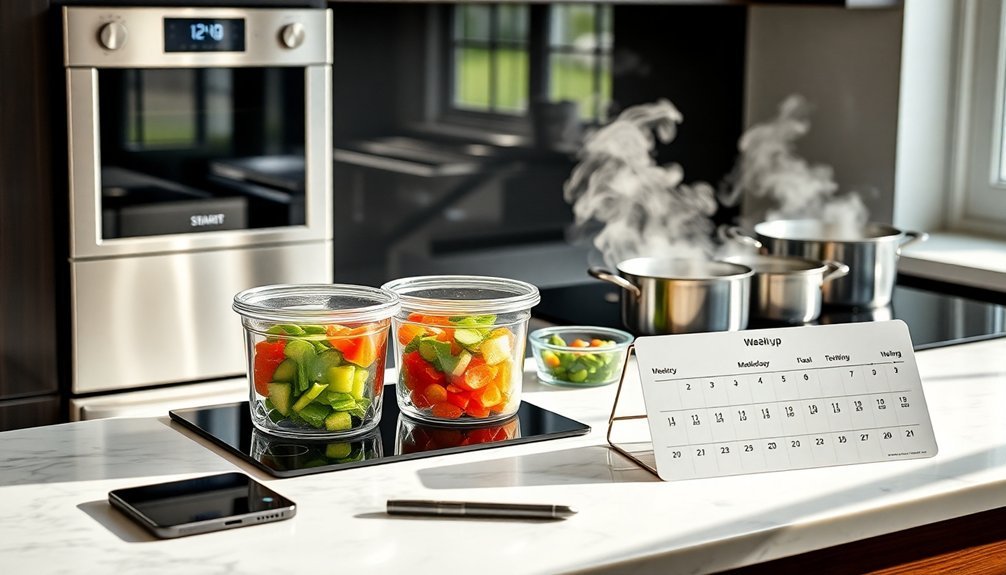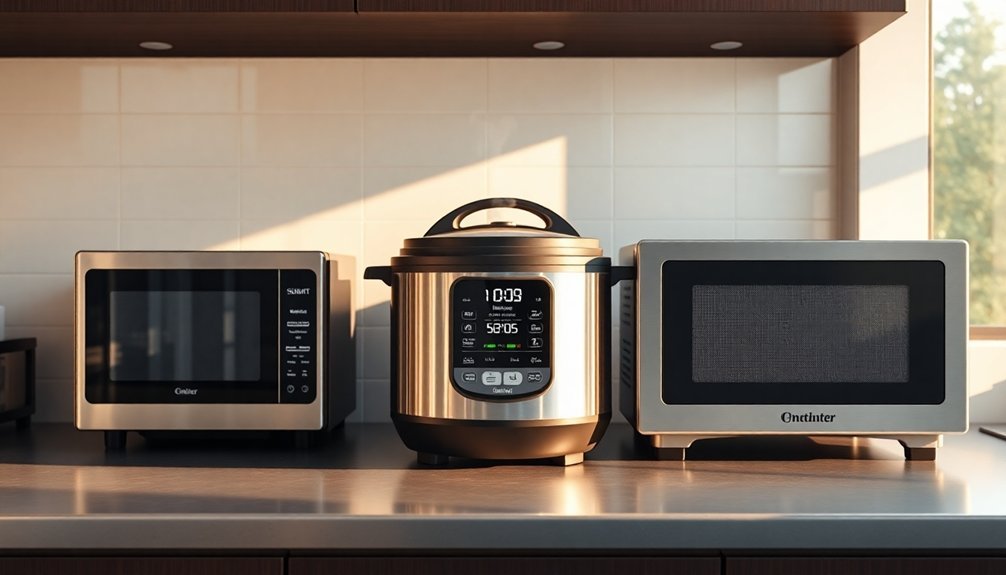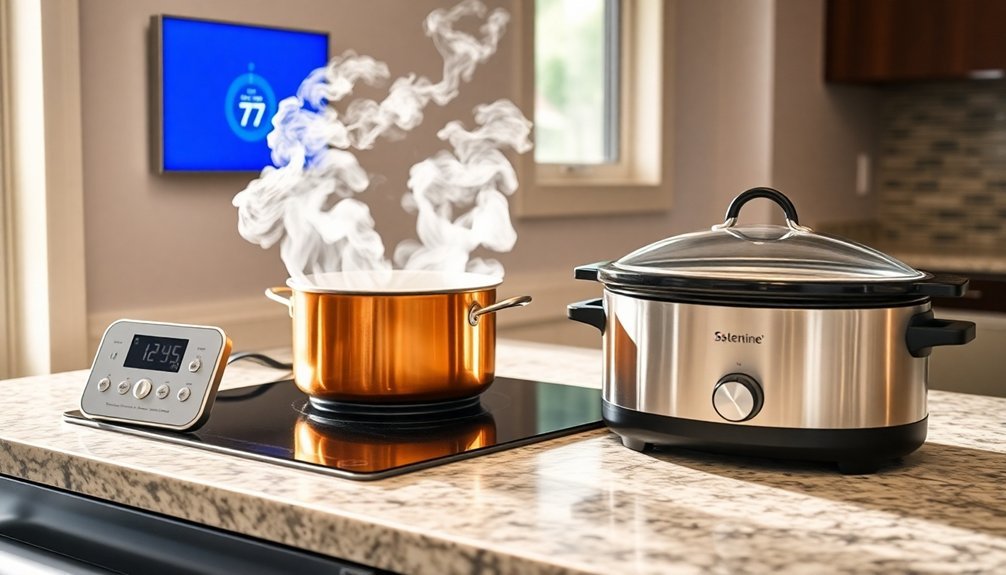You'll revolutionize your cooking routine by implementing smart kitchen tech and efficient methods. Start with the kitchen work triangle – keeping your fridge, stove, and sink within 5.5 feet for ideal flow. Connect WiFi-enabled appliances to your phone for remote monitoring and control. Use induction cooking for 84% efficiency, and embrace pressure cooking to slash cooking times by 70%. Batch cook larger portions of reheatable meals, and plan your weekly menu in advance to minimize waste. Choose energy-efficient appliances and match pot sizes to burners. These smart strategies are just the beginning of your journey toward a more efficient kitchen.
Smart Kitchen Setup Essentials

When designing a smart kitchen, establishing the right setup is essential for maximizing energy efficiency and productivity.
You'll want to follow the Triangle Rule by positioning your refrigerator, stove, and sink within 5.5 feet of each other, creating a workflow perimeter under 26 feet.
Install smart appliances that connect to a central hub or mobile app for streamlined control.
Your smart refrigerator should include built-in cameras and touchscreens for inventory management, while smart ovens with Advantium technology offer multiple cooking functions and automated temperature control.
Consider adding induction cooktops for faster cooking times and warming drawers for efficient food heating. Implementing IoT devices enables real-time monitoring of your kitchen's performance and energy usage.
Keep the design minimalist with hidden or built-in appliances, but don't sacrifice accessibility.
High-quality materials and finishes will enhance the aesthetic while maintaining functionality.
Energy-Saving Cooking Methods
A well-designed kitchen setup pairs perfectly with smart cooking methods to maximize energy savings. You'll greatly reduce energy consumption by choosing induction cooking over gas, as it's more than twice as efficient. When possible, opt for microwaves and slow cookers instead of your conventional oven. Convection ovens can reduce your energy usage by 20%.
| Method | Energy Saving | Time Saving |
|---|---|---|
| Induction | 84% efficiency | Quick heat response |
| Pressure Cooking | Less cooking time | 70% faster than conventional |
| Double Steaming | One burner for multiple dishes | Simultaneous cooking |
Match your pot size to burners and always use lids to trap heat. Bring food to room temperature before cooking and turn off the heat early to use residual warmth. For maximum efficiency, try batch cooking and plan meals that share similar cooking temperatures. When reheating, choose your microwave over the full-sized oven.
Meal Planning Efficiency

Strategic meal planning serves as the foundation for energy-efficient cooking and time management in the kitchen. You'll save significant time and energy by dedicating a specific day each week to plan your meals and create detailed shopping lists.
Start by selecting recipes with overlapping ingredients to minimize waste and simplify your grocery trips. Sunday or Monday is typically the best time to plan your weekly meals. You can streamline your cooking process by preparing proteins, grains, and vegetables in advance.
Cook larger portions of dishes that reheat well, like soups and casseroles, and portion them into individual containers for easy access.
Keep your plan visible by using a whiteboard or calendar, and consider implementing theme nights to maintain consistency.
Begin with planning just a few dinners per week, then expand as you become more comfortable with the routine.
Quick Cooking Techniques
Modern smart appliances and time-tested cooking methods combine to revolutionize kitchen efficiency.
You'll save significant time by using WiFi-enabled devices that let you monitor cooking progress from your phone while multitasking elsewhere. Smart ovens and air fryers offer pre-programmed settings that eliminate guesswork, while pressure cookers slash traditional cooking times. Smart thermometers ensure precise temperature control for perfectly cooked meals every time.
To maximize both time and energy savings, match your pot sizes to burner diameters and always cook with lids on.
You can cut prep time by using voice assistants to set timers or convert measurements. For the ultimate efficiency, consider integrated appliances like Thermomix® that combine multiple functions into one device.
During hot weather, opt for no-heat meal options or take your cooking outside to the grill, keeping your kitchen cool and energy bills lower.
Appliance Management Tips

Proper management of your kitchen appliances directly impacts both energy consumption and cooking efficiency.
You'll maximize performance by keeping your refrigerator and freezer organized with proper air circulation, while ensuring door seals remain tight. Don't put hot food directly into these appliances – let it cool first.
When using your stovetop, match pot sizes to burner sizes to prevent heat loss.
Take advantage of your oven's convection setting for faster, even cooking, and utilize residual heat after turning it off.
If you've got smart appliances, connect them to your home automation system for remote control and monitoring through your smartphone. You'll receive notifications when food is done and can adjust cooking parameters on the go.
Consider upgrading appliances over a decade old to more energy-efficient models.
Frequently Asked Questions
How Do Smart Appliances Communicate With Each Other in Case of Power Outages?
Your smart appliances can communicate during outages through wireless protocols like ZigBee or 433MHz radio, powered by backup batteries or UPS systems. They'll use MQTT brokers to maintain connectivity and send alerts via webhooks.
Can Smart Kitchen Devices Be Hacked, and What Security Measures Protect Them?
Yes, your smart kitchen devices can be hacked through weak passwords and unsecured networks. You'll need strong passwords, regular updates, and two-factor authentication to protect them from unauthorized access and potential breaches.
Do Smart Appliances Still Function Properly Without an Internet Connection?
Your smart appliances will still work for basic functions without internet, but you'll lose advanced features and app controls. They'll operate like traditional appliances, maintaining core functions through local connections or manual controls.
What Happens to Pre-Programmed Cooking Schedules During Daylight Saving Time Changes?
If you've connected your appliances to a smart home system, your pre-programmed cooking schedules will automatically adjust during DST changes. You won't need to manually reset them, as they'll sync with the new time.
Are Smart Kitchen Appliances Compatible With Solar-Powered Home Systems?
Yes, you'll find smart kitchen appliances are fully compatible with solar-powered homes. They work efficiently with solar generators, as long as you match the appliance wattage requirements with your system's power capacity.
In Summary
You'll save time, money, and energy by implementing these smart cooking strategies in your kitchen. From organizing your space efficiently to choosing energy-conscious cooking methods, you're now equipped to make meal preparation more streamlined. Remember to plan your meals ahead, use your appliances wisely, and embrace quick cooking techniques. With these habits in place, you'll create a more sustainable and efficient cooking routine.





Leave a Reply